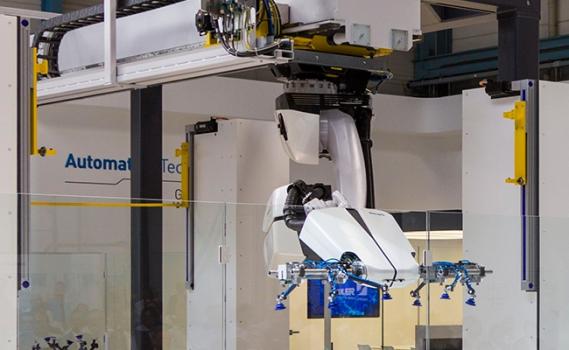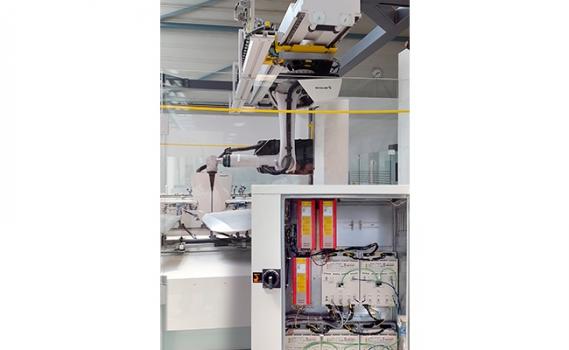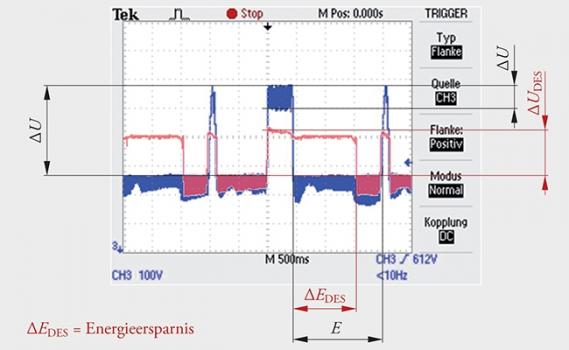Case Study: Robot Increases Productivity with Dynamic Energy Storage
Description
More output with increased efficiency
Large press lines with multiple stations require handling robots that convert the material from one press to the next. Reliability, speed, and precision are essential requirements that must be ensured for sustainable and smooth operation. Schuler Automation, who has been tasked with the automation of the press lines, offers the suitable handling robots for press linkage. The Crossbar Robot 4.0 integrates the DES 3.0 Dynamic Energy Storage module from Michael Koch, which helps make several dreams become reality.
The Crossbar Robot is designed for material handling in large presses and offers many benefits. It combines the field-proven technology of six-axis robots with the benefits of the Crossbar technology developed by Schuler Automation. The combination with the DES 3.0 Dynamic Energy Storage from Michael Koch GmbH makes the Crossbar Robot more dynamic, significantly more energy efficient, and even more reliable.
Six-axis robot with Schuler-technology
The Crossbar Robot 4.0 is based on a six-axes industrial robot, which Schuler Automation has expanded by two axes: a travel axis and an additional swivel axis. These axes make up the horizontal drive and additional variability on the robot head, offering a lot of freedom to move parts from one stage to the next in the press line. It can take up to four components from the tool simultaneously, reposition itself if necessary, and place these directly into the tool on the next press stage without interim storage.
The horizontal movement of the Crossbar Robot 4.0 takes place overhead under a hanging guiderail that is fastened above the press. As a result, the robot can fit in all press lines – either new or retrofitted, as it can easily maneuver through great distances between the press stations: from four and a half to ten meters. The Crossbar Robot 4.0 can also change the parts position during transport if necessary, which in turn eliminates the need for an intermediate, space-consuming interim storage station as is still common with older lines. It also increases performance significantly, making it particularly interesting when retrofitting existing press systems.
Weight reduction improves the dynamics
One prerequisite and helpful aspect associated with the dynamization of the robot’s operations is the significant reduction of the weight of the robot’s arm. The total weight of the Crossbar Robot 4.0 was reduced from 2,800 to 1,400 kg compared to the previous model. But despite the reduction of the robot’s weight, the maximum load capacity including tooling remained the same: supporting a weight of up to 90 kg. All things considered, this impressive weight reduction alone has led to a significant increase in efficiency, speed, and performance. Schuler Automation estimates an increase of up to 20% in the dynamics of Crossbar Robot 4.0 compared to its predecessor model.
The speed of this generation of robots makes it possible to remove workpieces from the press as early as in the opening phase. And the same goes for the loading: The robot arm and its holding tools are still in the press when the closing process begins. The robot’s dynamics make it possible to optimize the movements, making use of each and every second.
Significantly higher output through 15 strokes
Faster cycles also translate to higher drive dynamics. Acceleration and braking processes are more difficult with an electric system and a huge burden on the inverter. At the same time, more frequent braking means a corresponding increase in braking energy, which would negatively affect the energy balance if not utilized for the system.
Both issues are addressed by Michael Koch’s Dynamic Energy Storage DES 3.0. On the one hand, the burden on the drive electronics are drastically and sustainably reduced, which on the other hand makes it possible to raise the dynamics even further, i.e. increase the clock speed without any negative effects on the electronics. The Dynamic Energy Storage makes it possible to operate the Crossbar Robot at 15 cycles per minute in normal operation, which increases productivity on the press line by about twenty percent.
Relieves your drive electronics, saves energy
Koch’s Dynamic Energy Storage units are gentle on your drive controller by reducing the sharp voltage fluctuations in the DC link. In other words, reducing the energy buffer to a minimum. With each acceleration process, the voltage drops to the rectified mains level; with each braking process, it jumps to the brake chopper level. This difference of several hundred volts in a short sequence of fast cycles is very strenuous to the drive electronics. Not to mention the lower but high-frequency voltage peaks on the two extremes: the mains input voltage and the brake chopper voltage during braking.
These voltage fluctuations can be smoothened to a large extent by using the DES 3.0. When the robot brakes, the voltage in the DC link rises abruptly. The DES 3.0 absorbs the incoming braking energy from a certain voltage level and feeds it into its storage unit. This way, the DES 3.0 keeps the voltage of the drive controller’s DC link at a stable level, thus sparing the drive controller the burdens of voltage peaks and high-frequency chopper voltage jumps. In general, the RMS current is lowered, which in turn translates to a prolonged service life of the drive controller. Schuler Automation also takes advantage of this service life extension to increase the clock speed to a limit that is both sensible and mechanically feasible.
Braking energy utilized during acceleration
The acceleration of the robot would result in a significant voltage sag in the DC link. To prevent this, the dynamic energy storage steps in and feeds back the buffered electrical energy into the DC link. The voltage in the DC link is stabilized as long as there is sufficient energy stored in the DES. If it is running low, the drive controller gets the necessary power from the mains, whereby the voltage drops to the rectified mains voltage. Integration of the DES reduces the frequency and intensity of voltage fluctuations.
The second major advantage of the dynamic energy storage is experienced during acceleration: The active feedback of braking energy drastically improves the energy efficiency of the Crossbar Robot 4.0. The power consumption of the robot can be reduced by as much as 30% depending on the number of cycles per minute. Here, it should be noted that the absolute energy savings increase with the number of cycles, which as described above is only possible using DES 3.0.
Incredibly easy to use
With all these benefits, it’s not at all unreasonable to assume that the configuration and integration of the dynamic energy storage is a complex task. To the contrary, it only requires a simple connection of the DES to the DC link of the drive controller and everything else runs automatically – it doesn't even have a power button. No configuration or start-up actions are necessary: Simply install, connect, and it’s ready for use.
Improved performance, longer service life, and less energy consumption – a rare but very positive combination that comes in particularly handy in pressing lines. Certain advantages no longer come with compromises on many other aspects. Simply benefit from the combination of higher output with lower energy consumption and longer service life.
Specs
Photo Captions:
Photo 1: Fast and more efficient thanks to Michael Koch’s DES 3.0 Dynamic Energy Storage: The Crossbar Robot 4.0 from Schuler Automation
Photo 2: Increases the dynamics, reliability, and energy efficiency of the handling robot – The Crossbar Robot 4.0 from Schuler Automation: Michael Koch’s Dynamic Energy Storage (DES 3.0)
Photo 3: DES 3.0 Dynamic Energy Storage in the control cabinet of the Crossbar Robot 4.0 from Schuler Automation, for a great energy balance
Photo 4: Smoothing of the DC link voltage using Koch’s Dynamic Energy Storage speaks for itself – just like the resulting energy savings




